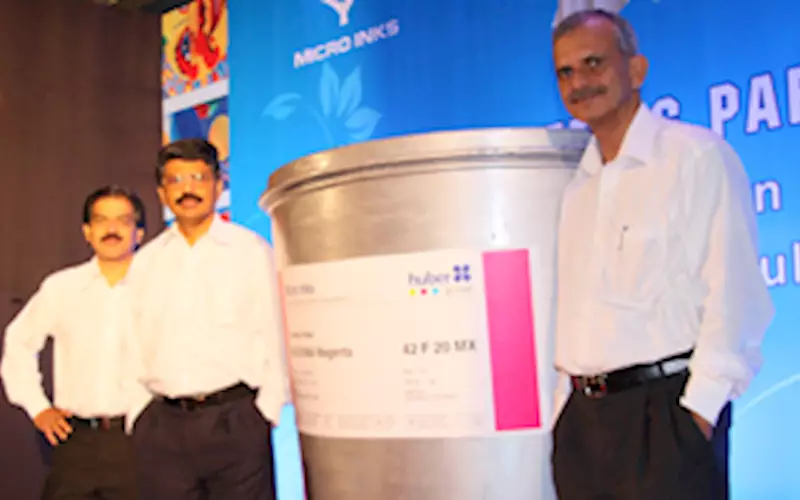Micro Inks launches Maxxima and ups investments in mother plant
Micro Inks launched its new Maxxima process colour ink set for sheetfed offset. The announcement of launch which was done through a series of meeting hosted in Kolkata, New Delhi and Mumbai in which top dealers across India participated.
27 Jul 2010 | By Ramu Ramanathan
Ashwani Bhardwaj(AB) speaks to Ramu Ramanathan(RR) about the future of Micro Inks.
RR: What are the key megatrends that have benefited the Indian print industry?
AB: Micro Inks offers the widest range of products and services to the Indian print industry. We have implemented the know-how of Huber group in our offset and UV products. Superior quality, well-designed product baskets and a host of services - like ATMs (our unique colour matching system ), knowledge sharing customer interactions, nationwide service network of highly qualified technicians are some of key customer service elements. Our entire supply chain is supported by the latest SAP ERP software to ensure always on-time supplies. Our backward integration helps create raw materials to ensure quality and consistency.
RR: Is Micro Inks a rule maker or a rule follower?
AB: Let us put it differently. We respond to our customer needs leveraging our strengths in the best possible manner. I think when it comes to quality and service, we set the bar. However, we try to keep track of the latest developments worldwide and there is always an opportunity to learn from our customers as well as competitors.
RR: Today, market boundaries are changing ever more quickly, targets are elusive and market capture is at best temporary. A few companies have proven themselves adept at inventing new markets, quickly entering emerging markets, and dramatically shifting patterns of customer choice in established markets.
AB: Success and leadership is all about passion, commitment and hard work. It is important to maintain close contacts with customers to stay abreast of the changing dynamics. In today's dynamic world, no one should take anything for granted. Ability to respond quickly to the changes is important.
RR: How does one emulate such companies?
AB: Basic business principles remain the same. We stick to our core values and beliefs.
RR: Benchmarking best practices allows enterprises to catch up with the competition, but it won't turn them into market leaders. Do you agree or no? Why?
AB: Yes I do agree. Benchmarking exercise of any kind is only a tool to improve. However leadership in the market place is the outcome of certain core competencies. A leader understands the market needs better and creates internal capabilities which are superior to others. However, as I said earlier, it is all about passion, commitment and hard work.
RR: What do you believe is the most under-recognised aspect in Indian printing that is likely to become important in the next decade?
AB: Indian printers have adopted the latest technologies very quickly over the last one decade. Our print shops are world class in all areas: pre-press, press and post-press. India also has the advantage of well qualified and trained technical people. However, not many printers have the scale to impress the big buyers in India and abroad. The industry also needs to bring in more professionalism in its working, particularly in the area of marketing.
RR: What does Green mean to Micro Inks?
AB: When it comes to Green, India has a long distance to cover. The country needs big steps in storage, movement, treatment and disposal of industrial waste and effluents.
RR: According to you what should the Green model in the print industry resemble?
AB: Green means many things: safe working environment inside the plants, no pollution of the environment and of course manufacturing products which are safe to the consumer. However it is a complex subject and each organisation has to set its own goals to achieve Green standards.
RR: When you get stuck in a business deal or a project ... how do dead-ends become new paths?
AB: Failures are part of life. The most important thing is not to get disheartened and not to give up, but to move on with hope and confidence.
RR: A lot of print companies in India have been struggling to cut costs. Most of them are discovering the hard way that they have for too long put up with too much redundant and wasteful activity.
AB: One good outcome of the recent economic troubles is that it has triggered 'the clean up act' at a feverish pitch. This has already resulted in lot of efficiencies. It is true that most of us only change under pressure.
RR: How do you mandate cost reductions and set targets?
AB: Certain changes may be painful in the short term, but necessary for long term survival.
RR: You've launched Maxxima, what else will your company do in 2010?
AB: Our slogan is – stay awake and keep moving. These are not the times to sit back and relax. We are working hard on innovation so that we can offer better products and solutions to our customers.
Other Q&A sessions with:
Ashok Nerker of Unique Photo Offset
Pratap Kamat of Uma Offset
Pranav Parikh of TechNova
Sanat Shah of Manugraph
K C Sanjeev of Welbound Worldwide
















 See All
See All